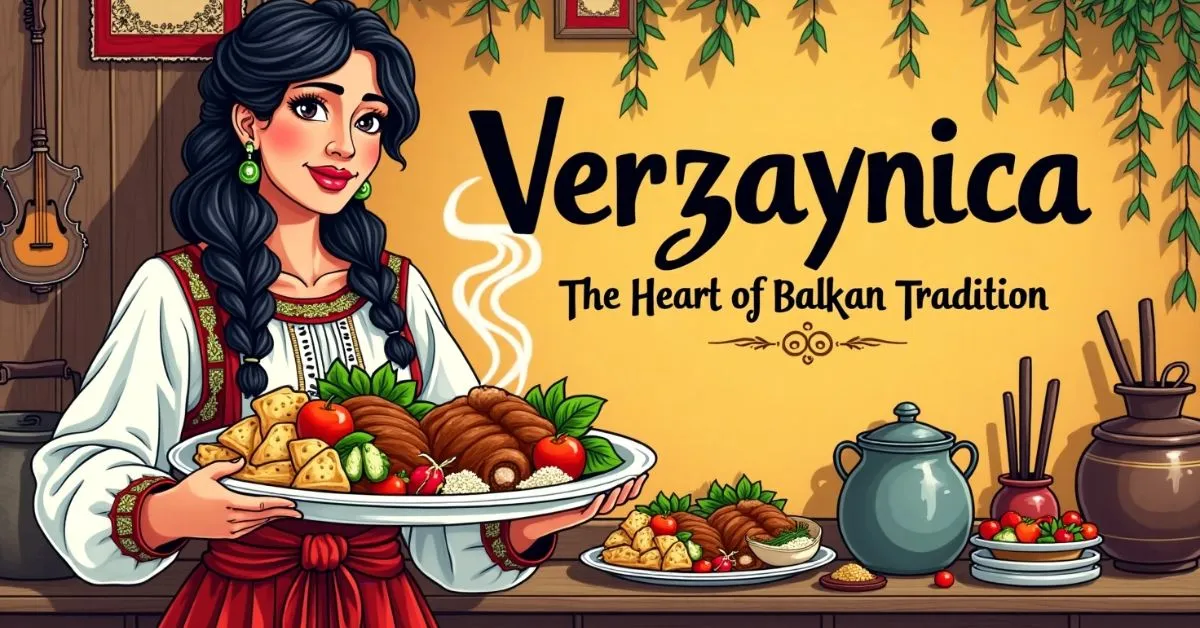q12In the rich culinary tapestry of the Balkans, certain foods stand out not only for their flavor but for their deep cultural significance. One such dish is Verzaynica, a traditional layered bread that has been a staple in the kitchens of Serbia, Croatia, Bosnia, and Montenegro for generations. Often associated with family gatherings, festive occasions, and cultural celebrations, Verzaynica is more than just a dish—it’s a symbol of warmth, unity, and shared tradition.
Whether it’s being prepared for a wedding, a religious holiday, or simply a cozy family get-together, Verzaynica has been passed down through the years, evolving while maintaining its connection to the heart of Balkan culture. In this article, we will explore everything there is to know about Verzaynica—from its history and cultural significance to its unique preparation technique and regional variations. We’ll also cover how you can make it at home and pair it with other dishes for a perfect meal.
The History and Cultural Significance of Verzaynica
Bread has always been a symbol of wealth, closeness to family, and camaraderie in the Balkans. Verzaynica, with its intricate preparation and rich flavor, embodies these values more than most. The bread has been an essential part of the region’s cultural celebrations, especially in Serbia, Croatia, Bosnia, and Montenegro, where it is frequently made for special occasions like weddings, religious holidays, and family gatherings.
For centuries, making Verzaynica has been a family tradition. In many homes, the preparation process is a group activity, with family members working together to roll the dough, layer it, and bake it. This not only strengthens the bond between family members but also reinforces the sense of community that is so deeply ingrained in Balkan culture.
Moreover, Verzaynica is a symbol of hospitality. In the Balkans, offering bread to guests is a gesture of warmth and welcoming. When made for special events, this bread signifies not just nourishment but also solidarity and shared joy.
Unique Preparation and Layering Technique
What truly sets Verzaynica apart from other breads is its multi-layered structure. The preparation process is both artistic and technical, requiring patience and skill. Here’s a closer look at the steps that go into making this delicious and unique bread.
The Dough – The Foundation of Verzaynica
The dough for Verzaynica is made using a combination of flour, yeast, warm milk, eggs, sugar, salt, and butter (or oil for a vegan option). The process starts by mixing these ingredients to form a smooth and elastic dough. The yeast activates, allowing the dough to rise and become airy, creating the perfect base for this multi-layered bread.
Rolling and Layering – Creating the Signature Texture
Once the dough has risen, it’s time to roll it out into thin sheets. Each sheet is then brushed with melted butter, ensuring the layers will separate during baking, creating that signature flaky texture. The layering process is repeated several times, with each layer building upon the last to create a delicate, airy texture that sets Verzaynica apart from other breads.
Shaping and Baking – Bringing it All Together
After the dough has been carefully layered, it is then rolled into a log shape and placed in a baking pan. The bread is left to rise once more before being baked at 375°F (190°C) for about 25-30 minutes. The result is a golden brown, flaky exterior with a soft, buttery interior, which makes each bite a delightful combination of textures.
This layering technique creates a bread that is not just delicious but also visually stunning, with each slice revealing its intricate layers.
Variations and Regional Twists on Verzaynica
While the basic recipe for Verzaynica remains consistent, there are several regional twists and family variations that add their own unique flavors and textures. These modifications give Verzaynica its own personal touch, adapting it to local tastes and traditions.
Cheese – A Savory Addition
In Serbia and Croatia, it’s common to add cheese to the layers of dough. Farmers’ cheese or feta is often used, adding a rich and savory twist to the bread. This variation creates a savory Verzaynica, perfect for those who enjoy a more sophisticated flavor.
Herbs and Spices – Aromatic Touch
Another variation includes the addition of herbs such as thyme, oregano, or rosemary. These herbs bring an aromatic depth to the bread, enhancing its flavor profile and making it more fragrant. This version is especially popular in households that enjoy bold, herbal flavors.
Dried Fruits – A Sweet Twist
For festive occasions, some people incorporate dried fruits like raisins or figs into their Verzaynica. These ingredients add a sweetness to the bread, making it a perfect pairing with tea or coffee. This sweetened version of Verzaynica is often served at holiday meals or special gatherings, where it adds a touch of indulgence to the table.
H3: Verzaynica in Modern Cuisine
Despite its traditional roots, Verzaynica has found its place in modern cuisine as well. As dietary preferences evolve, many bakers are adapting the recipe to meet the needs of a more diverse range of people.
Plant-Based Versions
In recent years, there has been a surge in plant-based diets, and Verzaynica is no exception. Many bakers now offer a vegan version of the bread by replacing butter with plant-based butter or olive oil. This adaptation allows vegetarians and vegans to enjoy this classic dish without compromising on flavor.
Gluten-Free Adaptations
Another modern modification is the introduction of gluten-free versions. This adaptation allows individuals with gluten sensitivities to partake in this cultural delicacy. Gluten-free flour blends, along with careful dough handling, ensure that the texture and taste of the bread remain close to the original, making it a suitable option for those with dietary restrictions.
Global Appeal
In addition to these dietary adaptations, Verzaynica has also piqued the interest of food enthusiasts and cultural explorers worldwide. The dish has transcended its Balkan roots and has been embraced by foodies from different parts of the world. This shift has led to a wider appreciation of Balkan culinary traditions, and Verzaynica is now a popular dish among those looking to explore the diverse flavors of the region.
Serving and Pairing Suggestions for Verzaynica
Verzaynica is as versatile as it is delicious. It can be enjoyed in many ways, depending on the occasion and personal preference. Here are some popular serving suggestions and pairings that will elevate your Verzaynica experience.
For Breakfast or Brunch
Verzaynica is a perfect addition to a hearty breakfast or brunch. Serve it warm with a spread of butter, honey, or jam for a comforting start to the day. The light, flaky texture of the bread pairs wonderfully with hot beverages like tea or coffee.
As an Accompaniment to Meals
Verzaynica can also be served as an accompaniment to soups, stews, or grilled meats. Its slightly crispy exterior and soft interior complement rich, savory dishes, making it a great side for heartier meals.
For Festive Occasions
During festive occasions, Verzaynica is often paired with traditional Balkan spreads like ajvar (a roasted pepper and eggplant spread) or kajmak (a creamy dairy product). These spreads add an additional layer of flavor to the bread, making it an integral part of the celebration.
For Afternoon Tea or Coffee
In some households, Verzaynica is enjoyed as a delightful afternoon treat alongside tea or coffee. The slight sweetness of the bread, especially when paired with dried fruits, makes it the perfect companion for a relaxing afternoon break.
How to Make Verzaynica at Home
Making Verzaynica at home is a rewarding experience that brings the flavors of the Balkans into your kitchen. Below is a simple recipe to guide you through the process.
Ingredients
- 4 cups all-purpose flour
- 1 packet active dry yeast
- 1 cup warm milk
- 2 eggs
- 2 tablespoons sugar
- 1 teaspoon salt
- 4 tablespoons melted butter (or oil for a vegan option)
Instructions
- Prepare the Yeast Mixture: In a bowl, dissolve the yeast in warm milk and let it sit for about 10 minutes, allowing the yeast to activate.
- Make the Dough: In a separate bowl, combine the flour, sugar, and salt. Add the yeast mixture and eggs, and knead until a soft dough forms.
- Let the Dough Rise: Place the dough in a warm spot and let it rise for about 1 hour or until it has doubled in size.
- Roll and Layer: Roll the dough into thin sheets and brush each layer with melted butter. Stack the sheets, then roll them into a log shape.
- Let It Rise Again: Place the dough log into a greased baking pan and let it rise for an additional 30 minutes.
- Bake: Bake at 375°F (190°C) for 25-30 minutes or until the bread is golden brown.
- Cool and Serve: Allow the bread to cool slightly before serving. Enjoy!
Conclusion
Verzaynica is much more than just a bread—it’s a culinary treasure that reflects the warmth, hospitality, and cultural richness of the Balkans. From its multi-layered texture to its cultural significance, it remains a beloved dish that brings families together. Whether enjoyed for a special celebration or as part of a daily meal, Verzaynica represents the very essence of Balkan tradition.
As it continues to evolve with modern twists and adaptations, Verzaynica remains a timeless symbol of family, community, and shared memories. So, gather your loved ones, roll up your sleeves, and enjoy the delicious flavors of Verzaynica—a bread that has been passed down through generations, connecting the past with the present.

